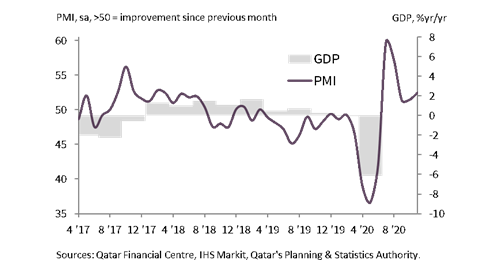Private Sector Expansion Builds Momentum Towards End of 2020

PMI rises to 52.5 in November, signalling accelerating growth in non-energy private sector
Qatar's non-energy private sector economy continued to expand towards the end of 2020, according to the November Purchasing Managers’ Index™ (PMI™) survey data. The rates of expansion in business activity, backlogs and employment all accelerated during the month, while new business registered another marked increase and the 12-month outlook for output remained positive.
The Qatar PMI indices are compiled from survey responses from a panel of around 400 private sector companies. The panel covers the manufacturing, construction, wholesale, retail, and services sectors, and reflects the structure of the non-energy economy according to official national accounts data.
The PMI rose to 52.5 in November, from 51.5 in October, to signal an improvement in operating conditions in the non-energy private sector. The latest reading was the seventh-highest on record since the series began in April 2017, compared with a long-run average of 49.6.
Growth rates for output, new business and employment among fastest in survey history
The rise in the headline figure in November reflected stronger positive contributions from the output and employment indicators. Output rose at the fastest rate since August, while the rate of job creation was the strongest since January 2019 that marks a return to pre-pandemic trends.
At the sector level, operating conditions strengthened the most in manufacturing this November, followed by construction and wholesale & retail respectively, while operating conditions at service providers were running in line with the long-run survey trend. Manufacturing registered the strongest rise in output among the four main sectors monitored, while construction companies posted the sharpest expansion in jobs. Manufacturers’ output is primarily destined to foreign markets, many in East Asia, where the effects of the pandemic have been milder than in Europe or the United States. Meanwhile, the effective local handling of the pandemic has enabled a return to safe operating conditions, including in labour-intensive construction activities.
The elevated level of the PMI was also influenced by one of the highest levels seen in the new orders index to date, indicative of improving demand. New business growth was again sufficiently strong to generate rising levels of incomplete work for the second month running. The backlogs index was the second-highest since July 2018, signalling emerging capacity constraints driven by a resurgence in demand and limited supply of local labour amidst pandemic controls.
Firms boost wages as business levels return to normal
Non-energy private sector firms raised average wages and salaries in November as business levels returned to normal. Meanwhile, purchasing prices fell and charges levied for goods and services decreased slightly, reflecting seasonal promotion activity.
The monthly PMI can be aggregated to a quarterly average to enable comparisons with official gross domestic product (GDP). Since the survey began in April 2017 the quarterly PMI has a correlation of 0.66 with the year-on-year percentage change in GDP in real terms, with a PMI reading of 50.0 equating to 0.2% growth on an annual basis. The latest official data reported a year-on-year decline of 6.1% in real terms in the second quarter of 2020, a figure heavily influenced by the lockdown measures implemented to contain the coronavirus outbreak. The PMI data for the third quarter of 2020 are consistent with a 2.7% year-on-year increase in GDP, and data for the first two months of the fourth quarter are signalling a further increase of 1.0%. Year-to-date PMI data confirms Qatar’s economic trajectory is more in-line with what is observed in China and other East Asian economies with a V-shaped recovery, rather than that seen in Europe or the United States.
QFC Qatar PMI™ vs. GDP

Comment
"Qatar’s non-energy private sector looks set to end 2020 with growth momentum building, according to the November PMI. Following a correction in September after the series record high set in July, the headline figure has now moved higher for two successive months. Growth rates for output and employment both accelerated during the month, with strong performances emanating from manufacturing and construction. New business growth also remains elevated and companies reported increasing pay packets as activity levels returned to pre-pandemic normal. Overall the PMI data are signalling a sustained rebound in GDP in the second half of 2020 following a short, sharp downturn in the second quarter."
Sheikha Alanoud bint Hamad Al-Thani
Managing Director of Business Development, QFC Authority



 Contrast View
Contrast View
 Increase Text
Increase Text
 Decrease Text
Decrease Text
 Reset Text
Reset Text



